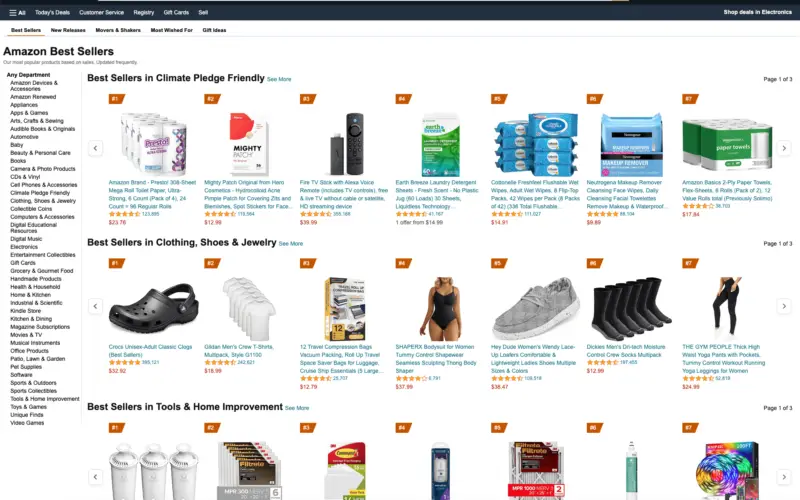As the world's largest online retailer, Amazon has become a popular destination for entrepreneurs and businesses looking to expand their customer base and increase sales. While some may be hesitant to sell their products on such a competitive platform, there are numerous benefits to doing so.
This article will outline these benefits and provide a comprehensive guide on how to set up an Amazon seller account, list products, price them competitively, manage inventory, advertise effectively, and analyze sales performance and customer feedback while scaling your business.
One common concern about selling on Amazon is the level of competition that exists within the marketplace. With millions of sellers offering similar products at different prices, it can seem overwhelming for newcomers trying to establish themselves. However, despite this apparent challenge, there are many reasons why selling on Amazon is worth considering.
For one thing, it provides access to a massive customer base that spans across multiple countries around the globe. Additionally, Amazon offers various tools and resources that can help sellers improve their visibility and reach more potential customers than they would otherwise be able to do independently.
Following proven strategies for success on this platform outlined in this article will help you overcome any reservations you may have about selling your products successfully on Amazon.
READ ALSO: 13+ High Paying Side Hustles In Canada
- Benefits of Selling on Amazon
- Setting Up an Amazon Seller Account
- Listing Your Products
- Pricing Your Products
- Managing Your Inventory
- Fulfilling Orders
- Advertising Your Products
- Analyzing Your Sales Performance
- Customer Service and Feedback
- Scaling Your Business on Amazon
- Frequently Asked Questions
- Conclusion
Benefits of Selling on Amazon

The advantages of utilizing Amazon as a sales platform include a range of benefits that can help businesses achieve growth, such as increased visibility, access to a vast customer base, and the ability to leverage Amazon's logistics and fulfillment services.
By listing products on Amazon, businesses can tap into an enormous pool of potential customers who are already familiar with the platform and trust it as a reliable source for online purchases. This means that businesses can benefit from increased exposure to new audiences without having to invest significant resources in marketing and advertising.
Additionally, Amazon offers various tools and services that enable sellers to optimize their listings and improve their chances of making sales. For example, sellers can use the platform's data analytics tools to gain insights into customer behavior and preferences, which they can then use to tailor their product offerings accordingly.
Furthermore, by using Amazon's logistics and fulfillment services (such as Fulfillment by Amazon), sellers can streamline their operations and focus on other aspects of growing their business while leaving the shipping and handling tasks up to Amazon.
Overall, the benefits of selling on Amazon are numerous for businesses looking for growth potential in today's competitive e-commerce landscape.
From increased visibility to access to a massive customer base and logistical support from one of the world's leading online retailers – there is no doubt that leveraging this sales platform is an effective way for companies to reach new heights in terms of revenue generation, brand recognition, and more.
READ ALSO: Side Hustles For Stay-At-Home Parents In USA
Setting Up an Amazon Seller Account
To begin the process of becoming a seller on the world's largest online marketplace, one must first create an Amazon Seller Account.
This account allows sellers to access Amazon's suite of seller tools and resources that enable them to manage their inventory, fulfill orders, and communicate with customers. The process is relatively straightforward and begins by visiting the Amazon Seller Central website.
Once there, potential sellers will be prompted to enter some basic information such as their name, email address, and business name. They will then need to provide additional details about their business, including its legal structure and tax identification number. Once this information has been verified by Amazon, sellers can start creating listings for their products.
One key aspect of setting up an Amazon Seller Account is determining payment options for customers. Sellers have several choices in this regard, including Fulfillment by Amazon (FBA), which allows Amazon to handle all aspects of order fulfillment on behalf of the seller.
Alternatively, sellers can choose to handle shipping themselves or use a third-party logistics provider. Regardless of which option they choose, it is essential that sellers ensure that they are providing secure payment options for their customers in order to build trust and drive sales.
| Payment Option | Description | Pros |
|---|---|---|
| FBA | Allows Amazon to handle all aspects of order fulfillment on behalf of the seller | Convenient for busy or inexperienced sellers; increases visibility with Prime eligibility |
| Merchant-fulfilled | Seller handles all aspects of order fulfillment themselves or through a third-party logistics provider | More control over shipping methods and costs; allows for more customization |
| Multi-Channel Fulfillment (MCF) | Allows sellers to fulfill orders from other sales channels using FBA inventory | Provides flexibility across multiple platforms; simplifies inventory management |
Setting up an Amazon Seller Account is essential for those looking to sell products on the platform. Creating listings is easy once your account has been established, and selecting the right payment options is key to building trust with customers and driving sales.
By utilizing the tools and resources provided by Amazon, sellers can efficiently manage their inventory, fulfill orders, and grow their business on one of the world's most popular e-commerce platforms.
Listing Your Products
Listing your merchandise on the Amazon platform can be a challenging task for new sellers who may face difficulty in optimizing their product descriptions to gain maximum visibility. However, by utilizing Amazon's keyword research tools and following optimization best practices, sellers can improve their listings and increase sales.
Optimization involves improving various aspects of your listing, such as title, description, images, and pricing. Here are three ways to optimize your Amazon listings:
Use relevant keywords: Research the most relevant keywords for your products using Amazon's Keyword Tool or other keyword research tools. Incorporate these keywords in your titles, bullet points, and descriptions to help customers find your products easily.
Write compelling product descriptions: Your product description should be accurate, concise yet comprehensive. It should include all necessary information about the product such as its features, dimensions, materials used, etc., while also highlighting how it solves a customer's need or problem. You can use stevv.com for this.
Optimize images: Images play a crucial role in attracting customers' attention towards your products. Make sure that you use high-quality images that clearly depict the product from multiple angles with zoom-in options available. Also, ensure that the image size is optimized for quick loading speed without compromising on quality.
By implementing these optimization techniques into your listings on Amazon's marketplace platform you can increase visibility and drive more traffic to your store resulting in increased sales potential for your business.
Pricing Your Products
When selling products on Amazon, it is important to have a clear understanding of the platform's pricing structure. This involves taking into account various fees such as referral fees, fulfillment fees, and storage fees.
Additionally, conducting a competitor analysis can provide valuable insights into how to set competitive prices that will attract customers while still maintaining profitability.
By carefully considering these key factors, sellers can optimize their pricing strategies for success on Amazon.
Understanding Amazon's Pricing Structure
Amazon's pricing structure is intricately designed to balance affordability for customers and profitability for sellers. Amazon employs a sophisticated pricing algorithm that takes into account various factors such as product demand, competition, and sales history to determine the best price for a particular product at any given time.
This dynamic pricing strategy allows sellers to adjust their prices in real time based on changing market conditions. One of the key advantages of Amazon's pricing structure is that it offers transparency and fairness to all sellers. The platform charges a referral fee and closing fee on each sale, which varies depending on the category of the product sold.
However, these fees are clearly outlined in advance so that sellers can make informed decisions when setting their prices. Moreover, Amazon also provides tools like the Buy Box feature that helps increase visibility and sales for products with competitive prices, thereby incentivizing sellers to offer reasonable prices while maintaining profitability.
Overall, by providing a level playing field and utilizing advanced algorithms, Amazon's pricing structure benefits both customers and sellers alike.
Competitor Analysis
Conducting a thorough competitor research analysis is crucial for any business that aims to sell products on Amazon.
Competitor analysis can provide businesses with valuable insights into the market they operate in, helping them identify opportunities and threats.
To conduct an effective competitor research analysis, sellers must first identify their main competitors and then analyze their pricing strategies, product offerings, marketing tactics, and customer reviews.
Market analysis is another important aspect of successful selling on Amazon. Sellers need to understand market trends and consumer behavior before deciding on a pricing strategy or product offering.
By analyzing market data such as sales figures and consumer demographics, sellers can gain a better understanding of the demand for their products and make informed decisions about pricing and inventory management.
Overall, conducting thorough competitor research analysis and market analysis are essential steps in developing a successful selling strategy on Amazon.
Setting Competitive Prices
Setting competitive prices is a critical component of an effective business strategy, as research shows that 80% of Amazon shoppers compare prices before making a purchase.
In order to set competitive prices, sellers need to understand the market and their competitors' pricing strategies. Dynamic pricing can be useful in this regard, as it allows sellers to adjust their prices in real time based on market conditions and competitor actions.
There are several pricing strategies that can help sellers set competitive prices on Amazon. One such strategy is cost-plus pricing, where the seller adds a markup to the cost of the product to arrive at the selling price.
Another approach is value-based pricing, where the seller sets the price based on the perceived value of the product to customers.
Finally, penetration pricing can be used by new entrants into a market, where they offer lower prices than established competitors in order to gain market share.
By using these strategies and staying up-to-date with market trends and competitor actions through dynamic pricing, sellers can effectively set competitive prices on Amazon.
READ ALSO: Creative Side Hustles For Uk Residents
Managing Your Inventory
Effective inventory management is crucial for success in selling products on Amazon as it ensures that your stock levels are always optimized to meet customer demand.
One of the key aspects of managing your inventory is inventory tracking. You must track your inventory at all times to ensure that you have the right amount of stock available when customers place an order.
Inventory tracking involves keeping a close eye on the quantity and status of each item in your stock, including how many items are currently available, how many have been sold, and how many are on order from suppliers.
It is important to set up a system for tracking your inventory accurately and efficiently. This can be done manually using pen and paper or through advanced software programs designed specifically for this purpose.
Stock management is another critical element of effective inventory management when selling products on Amazon. It involves monitoring trends, analyzing sales data, forecasting demand, and making informed decisions about what products to stock in what quantities.
By regularly reviewing sales reports, you can identify which products are selling well and which ones need more attention. When you keep your stock levels optimized based on market trends and customer demand, you can reduce storage costs while ensuring that you always have enough products on hand to fulfill orders promptly.
Fulfilling Orders
Fulfillment of orders on e-commerce platforms is a critical aspect of the supply chain process, with 96% of customers stating that delivery time is an important factor in their purchasing decision.
Amazon sellers must ensure timely and accurate shipment of products to maintain a positive reputation and customer loyalty.
To facilitate efficient order fulfillment, Amazon offers two primary shipping options: Fulfillment by Amazon (FBA) or Merchant Fulfilled Network (MFN).
Fulfillment by Amazon (FBA) is a popular choice for many sellers as it provides numerous benefits such as access to Prime shipping, storage, and handling services, and customer service.
With FBA, sellers send their inventory to an Amazon warehouse where it is stored until an order is placed on the platform.
The product is then picked from the warehouse, packed, and shipped directly to the customer by Amazon. This option eliminates most of the logistical challenges associated with order fulfillment.
Merchant Fulfilled Network (MFN), on the other hand, requires the seller to store inventory at their own location and handle all aspects of packing and shipping when an order comes in.
This option allows for greater control over the fulfillment process but also requires more effort from the seller in terms of logistics management.
Regardless of which option a seller chooses, tracking orders throughout each stage of fulfillment ensures timely delivery and provides valuable data for optimizing future processes.
Advertising Your Products
Promotion of merchandise through targeted campaigns and sponsored listings can increase visibility and generate interest among potential buyers. Targeted advertising is a powerful way to reach specific audiences based on their interests, demographics, and behaviors.
This approach allows sellers to focus their resources on consumers who are most likely to be interested in their products, leading to higher conversion rates and sales.
Sponsored products are another effective way to advertise on Amazon. These ads appear at the top of search results or product detail pages, increasing the chances that shoppers will see them.
Sponsored products use pay-per-click (PPC) advertising, meaning sellers only pay when someone clicks on their ad. This approach gives sellers more control over their advertising budget and allows them to track the effectiveness of their campaigns.
To make the most of targeted advertising and sponsored products, it's important for sellers to understand their audience and create compelling ads that resonate with them.
This requires research into consumer behavior, competitor analysis, keyword optimization, and creative execution. By investing time and resources into these activities, sellers can increase the visibility of their products on Amazon and drive more sales over time.
Analyzing Your Sales Performance
One important aspect of running a successful e-commerce business involves regularly analyzing sales performance to identify trends and make data-driven decisions for future growth. Without proper tracking metrics, it is impossible to evaluate the efficacy of your advertising campaigns or understand which products are resonating with customers.
Analyzing your sales performance can help you identify areas where you excel and those that need improvement. Performance evaluation is crucial for any e-commerce business as it provides a clear understanding of how well your products are selling.
Tracking metrics such as conversion rate, revenue per visitor, and customer acquisition cost can give you insights into the effectiveness of your marketing efforts. Additionally, evaluating product-specific performance can help you determine which products are worth investing in further.
By consistently reviewing and analyzing sales performance, businesses can make informed decisions about future growth strategies. This includes identifying areas where additional resources may be needed, such as increased investment in advertising or expanding product lines.
Ultimately, regular evaluation of sales performance allows businesses to stay ahead of the competition by making data-driven decisions that keep them agile and responsive to changing market conditions.
READ ALSO: 15 Best Side Hustles For Graduate Students
Customer Service and Feedback
Effective customer service and feedback management are crucial elements of selling products on Amazon. Responding to customer inquiries promptly and professionally can improve customer satisfaction, leading to increased sales and positive reviews.
It is equally important to handle negative feedback appropriately, addressing the concerns of customers in a constructive manner while encouraging positive reviews through excellent service.
Responding to Customer Inquiries
When responding to customer inquiries, response time is crucial. Amazon sellers should aim to reply as quickly as possible, preferably within 24 hours. Delayed responses can lead to frustration and dissatisfaction on the part of the customer which may result in negative feedback or even a loss of business.
Furthermore, prompt responses show customers that their concerns are taken seriously and that the seller is committed to providing excellent service.
In addition, professionalism should be maintained when addressing customer inquiries. This means using appropriate language, avoiding jargon or colloquialisms that may confuse or offend customers, and ensuring that all information provided is accurate and complete.
Communication with customers should be respectful at all times regardless of how difficult the situation may be.
In conclusion, by prioritizing response time and maintaining a professional tone when responding to customer inquiries, Amazon sellers can build a positive reputation for their brand while ensuring customer satisfaction.
Handling Negative Feedback
Managing negative feedback is an important aspect of maintaining a positive reputation for one's brand on e-commerce platforms. Dealing with criticism can be challenging, but it is essential to respond professionally and take appropriate actions to address the issue.
To handle negative feedback effectively, here are four tips that sellers can follow:
Don't ignore negative reviews – ignoring them may make customers feel unheard, leading to further dissatisfaction.
Respond promptly and professionally – acknowledge the customer's concern and offer a solution or apology.
Address the root cause – identify the reason behind the negative review and take steps to prevent similar issues in the future.
Encourage positive feedback – by providing excellent customer service, sellers can increase their chances of receiving positive reviews.
By following these guidelines, sellers can turn negative feedback into an opportunity to improve their business practices and strengthen their brand reputation on e-commerce platforms like Amazon.
Encouraging Positive Reviews
Having discussed the importance of addressing negative feedback on Amazon, it is equally important to encourage positive reviews to improve your product's visibility and credibility.
Incentivizing reviews is one of the most effective ways to encourage customers to leave a review. This can be done by offering discounts or coupons for future purchases, free products, or entry into a prize draw.
However, incentivizing reviews need to be done ethically and in accordance with Amazon's guidelines. It is essential that you do not offer incentives in exchange for only positive reviews as this violates Amazon's policies and can result in account suspension.
Instead, focus on getting honest feedback from customers and rewarding them for taking the time to leave a review.
Apart from incentivizing reviews, there are also several review management strategies that can help build your reputation on Amazon.
These include responding promptly and professionally to all customer feedback (both positive and negative), using targeted email campaigns to request feedback from satisfied customers, and optimizing your product listing with high-quality images and informative descriptions that accurately represent your product's features and benefits.
By incorporating these strategies into your overall marketing plan, you will boost your sales through increased visibility on Amazon while building trust among potential buyers.
Scaling Your Business on Amazon
Ironically, neglecting to scale your business on Amazon can lead to stagnant sales and ultimately hinder the success of your products. As an Amazon seller, it is essential to explore ways of expanding reach and diversifying products to stay relevant in the market.
One way of scaling your business on Amazon is by optimizing product listings. This involves using relevant keywords, creating compelling product descriptions, and providing high-quality images.
Another strategy for scaling your business on Amazon is by leveraging the Fulfillment by Amazon (FBA) program. FBA allows sellers to store their inventory in Amazon's fulfillment centers, where the company takes care of shipping, handling returns, and customer service.
By utilizing FBA services, sellers can focus on growing their businesses without worrying about logistics or fulfillment issues.
Staying up-to-date with industry trends and implementing new marketing strategies can also help scale your business on Amazon. This includes utilizing social media platforms such as Facebook and Instagram to promote products and running targeted advertising campaigns that reach a wider audience.
Ultimately, scaling a business on Amazon requires strategic planning, careful execution, and constant adaptation to changing market conditions.
READ ALSO: Real Estate Investing In The Uk
Frequently Asked Questions
What are the most common mistakes that Amazon sellers make?
Common mistakes made by sellers on Amazon include inaccurate pricing strategies and a lack of effective customer engagement.
These errors can lead to reduced sales and negative feedback from customers, highlighting the importance of careful planning and execution in online retail.
How can I protect my products and intellectual property on Amazon?
Trademark registration and brand registry are crucial for protecting products and intellectual property on Amazon. Failure to do so can result in lost revenue, negative reviews, and legal action.
It's like leaving your house unlocked – inviting theft and damage.
What steps should I take to avoid getting suspended or banned from selling on Amazon?
To avoid suspension or banning from Amazon, sellers should prioritize compliance with Amazon's policies and maintain positive seller performance metrics.
This can be achieved through timely order fulfillment, excellent customer service, accurate product descriptions, and prompt response to customer inquiries and complaints.
What are the best practices for optimizing product listings and increasing sales?
Optimizing product listings and increasing sales requires careful attention to product photography and keyword research.
Professional, knowledgeable descriptions can persuade buyers to choose your product over competitors'.
Coincidentally, these best practices align with Amazon's guidelines for successful selling.
How can I effectively compete with other sellers and stand out in a crowded marketplace?
To effectively compete in a crowded marketplace, sellers can employ differentiation strategies and brand awareness tactics.
By offering unique products or services, highlighting benefits, and building a strong brand presence, sellers can distinguish themselves from competitors and attract customers.
Conclusion
In conclusion, selling products on Amazon can be an excellent way to expand your business and reach a wider audience. By setting up an Amazon seller account, listing your products, pricing them competitively, managing inventory efficiently, advertising effectively, analyzing sales performance regularly, and providing exceptional customer service and feedback responses, you can scale your business on this platform.
Just like planting a seed in fertile soil and nurturing it with proper care and attention leads to a fruitful harvest; similarly, investing time and effort into building a successful Amazon storefront will yield bountiful returns for your business.
So take advantage of the benefits that Amazon has to offer and watch as your sales grow exponentially over time. Remember that success is not achieved overnight but rather through consistent hard work and dedication toward achieving your goals.
I believe this article was helpful to you and that you enjoyed every bit of it. Please feel free to leave us a comment below if you have any. Also, help us share this article on social media to help us reach more people who needs this information. Thanks!!! Follow Us on Socials: LinkedIn - Facebook - Twitter
Discover more from iParrot Wealth
Subscribe to get the latest posts sent to your email.









